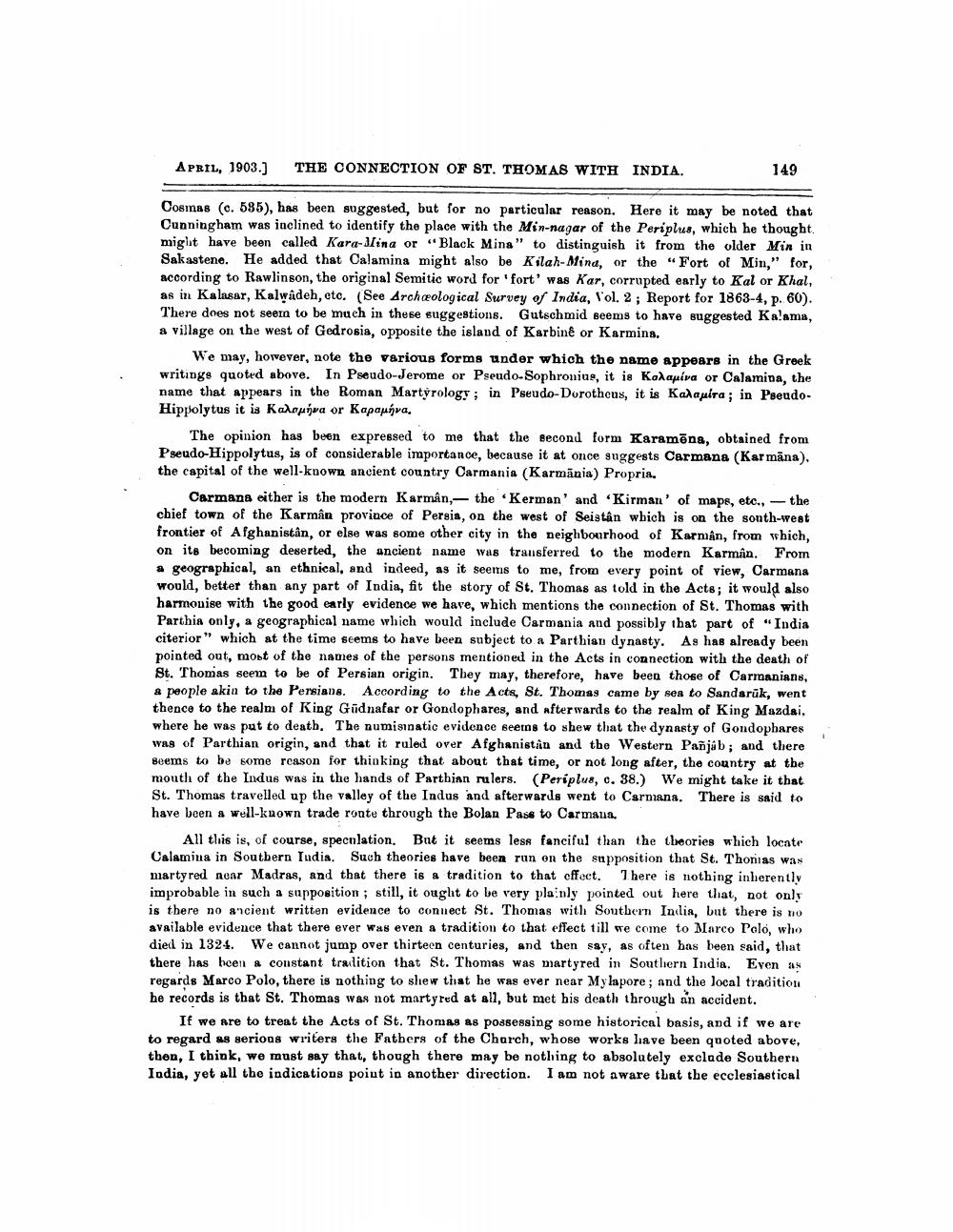________________
April, 1903.)
THE CONNECTION OF ST. THOMAS WITH INDIA.
149
Cosmas (c. 585), has been suggested, but for no particular reason. Here it may be noted that Cunningham was inclined to identify the place with the Min-nagar of the Periplus, which he thought. miglit have been called Kara-Jina or “Black Mina" to distinguish it from the older Min in Sakastene. He added that Calamina might also be Kilah-Mina, or the "Fort of Min," for, according to Rawlinson, the original Semitic word for 'fort' was Kar, corrupted early to Kal or Khal, as in Kalasar, Kalwadeh, etc. (See Archeological Survey of India, Vol. 2 ; Report for 1863-4, p. 60). There does not seern to be much in these suggestions. Gutschmid seems to have suggested Kalama, a village on the west of Gedrosia, opposite the island of Karbine or Karmina.
We may, however, note the various forms under which the name appears in the Greek writings quoted above. In Pseudo-Jerome or Pseudo-Sophronius, it is Kalapíva or Calamina, the name that appears in the Roman Martyrologs; in Pseudo-Dorotheus, it is Kalapira ; in PseudoHippolytus it is Kalapýva or Kapapýva,
The opinion has been expressed to me that the second form Karamēna, obtained from Pseudo-Hippolytus, is of considerable importance, because it at once suggests Carmana (Kar māna), the capital of the well-known ancient country Carmania (Karmania) Propria.
Carmans either is the modern Karman,- the Kerman' and Kirman' of maps, etc., - the chief town of the Karman province of Persia, on the west of Seistân wbich is on the sonth-west frontier of Afghanistan, or else was some other city in the neighbourhood of Karman, from which, on its becoming deserted, the ancient name was transferred to the modern Karman. From a geographical, an ethnical, and indeed, as it seems to me, from every point of view, Carmana would, better than any part of India, fit the story of St. Thomas as told in the Acts; it would also harmonise with the good early evidence we have, which mentions the connection of St. Thomas with Parthia only, a geographical name which would include Carmania and possibly that part of "India citerior" which at the time seems to have been subject to a Parthian dynasty. As has already been pointed out, most of the names of the persons mentioned in the Acts in connection with the death of St. Thomas seem to be of Persian origin. They may, therefore, have been those of Carmanians, & people akin to the Persians. According to the Acts, St. Thomas came by sea to Sandarūk, went thence to the realm of King Gudnafar or Gondophares, and afterwards to the realm of King Mazdai. where he was put to death. The numismatic evidence seems to shew that the dynasty of Gondophares was of Parthian origin, and that it ruled over Afghanistan and the Western Pañjáb; and there seems to be some reason for thinking that about that time, or not long after, the country at the mouth of the Indus was in the hands of Parthian rulers. (Periplus, c. 38.) We might take it that St. Thomas travelled up the valley of the Indus and afterwards went to Carmana. There is said to have been a well-known trade ronte through the Bolan Pase to Carmana
All this is, of course, speculation. But it seems less fanciful than the theories which locate Calamina in Southern Tudia. Such theories have been run on the supposition that St. Thonias was martyred near Madras, and that there is a tradition to that offect. There is nothing inherently improbable in such a supposition; still, it ought to be very plainly pointed out here that, not only is there no ancient written evidence to connect St. Thomas with Southern India, but there is no available evidence that there ever was even a tradition to that effect till we come to Marco Polo, who died in 1324. We cannot jump over thirteen centuries, and then say, as often bas been said, that there has been a constant tradition that St. Thomas was martyred in Southern India. Even as regards Marco Polo, there is nothing to shew that he was ever near Mylapore ; and the local tradition he records is that St. Thomas was not martyred at all, but met his death through an accident.
If we are to treat the Acts of St. Thomas as possessing some historical basis, and if we are to regard as serious writers the Fathers of the Church, whose works liave been quoted above, then, I think, we must say that, though there may be nothing to absolutely exclude Southern India, yet all the indications point in another direction. I am not aware that the ecclesiastical




